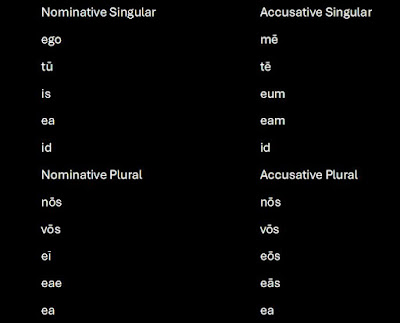[The Road to Latin (Chesnutt) 1932]
Text A: Tullia, Magistra Fīliārum I
Two points of grammar will be discussed based on these short texts but first read them and use the vocabulary and notes to help you.
In text A, revise the forms of esse in italics.
In text B, revise the forms of first conjugation verbs in italics.
In both texts, look at the verbs in bold.
Text A: Tullia, Magistra Fīliārum I
Tullia Cornēliam et Secundam linguam Latīnam docet. Tullia sevēra magistra est; itaque puellae dīligenter student. “Ego sum fēmina. Ego sum mātrōna Rōmāna. Tū, Cornēlia, es puella. Tū es fīlia mea. Secunda quoque est puella Rōmāna. Secunda est parva fīlia mea. Sum mātrōna Rōmāna; es fīlia mea; Secunda est parva fīlia mea.”
“Sum incola Rōmae. Tū Cornēlia, quoque es incola Rōmae. Ego et tū sumus incolae Rōmae. Nōs sumus laetae. Tū, Cornēlia, es fīlia mea. Tū quoque, Secunda, es fīlia mea. Vōs, puellae, estis fīliae meae. Estis puellae cārae. Lūcia est fīlia Camillae. Tertia est parva fīlia Camillae. Lucia et Tertia sunt fīliae Camillae.”
Text B: Tullia, Magistra Fīliārum II
“Nōnne rosae sunt pulchrae, fīliae meae? Māne ego in vīllam rosās portō. Tū, cornēlia, aquam portās. Secunda quoque aquam portat. Tum nōs rosās ad statuās deārum portāmus et statuās ōrnāmus. Vōs puellae rubrās rosās amātis et vestrās rosās ad Diānae statuam portātis. Cotidiē agricolae corbulās plēnās rosārum ad vīllam nostram portant. Ego rosās libenter cūrō.”
“Nōnne corōnae rosārum pulchrae sunt, puellae? Vidēsne corōnam rosārum albārum, Cornēlia?” “Corōnam videō, Tullia. Nōnne est pulchra?” “Videtne dea Diāna corōnās, Tullia?” “Certē, mea fīlia parva! Deae omnia vident.” “Sed nōs deās nōn vidēmus.” “Vōs, puellae, deās nōn vidētis quod deae in terrā nōn habitant.”
Vocabulary
ad: preposition that takes the accusative case; to(wards)
cārus, -a, -um: dear
certē: certainly; of course
corbula: basket
corōna: garland
curāre: to look after; take care of
docēre: to teach
incola: inhabitant; first declension, but can be masculine or feminine
libenter: willingly
manē: in the morning
mātrōna: married woman
omnia: all (things)
ōrnāre: decorate; adorn
plenus, -a, -um: full
rosa: rose
ruber, rubra, rubrum: red
sevērus, -a, -um: strict
studēre: be eager; study
terra: land; the earth
vidēre: to see
Notes:
[i]
Vōs puellae rubrās rosās amātis et vestrās rosās ad Diānae statuam portātis.
You girls love the red roses and bring your roses to the statue of Diana.
Cotidiē agricolae corbulās plēnās rosārum ad vīllam nostram portant.
Every day the farmers bring baskets full of roses to our villa.
noster, nostra, nostrum is a possessive adjective and pronoun; it is the plural of meus / mea / meum i.e. it means 'our(s)' and declines in exactly the same way; note the loss of /e/ noster > nostra
vester, vestra, vestrum is a possessive adjective and pronoun; it is the plural of tuus / tua / tuum i.e. it means 'your(s)' when talking to more than one person and declines in exactly the same way; again, note the loss of /e/ vester > vestra
[ii] docēre: to teach; studēre: be eager / study; vidēre: to see are all examples of second conjugation verbs. Note the long /ē/ in the infinitives which marks them as second conjugation as opposed to long /ā/ which marks the first conjugation. While, as has been mentioned before, the use of the macron above vowels was not used in Classical Latin, it is advisable to note these 2nd conjugation verbs with the macron for reasons which will become apparent when other verb conjugations are studied. Go to the next post for information on second conjugation verbs.
[iii] The third point to note will, at this stage, be brief:
Sum incola Rōmae. Tū Cornēlia, quoque es incola Rōmae. Ego et tū sumus incolae Rōmae.
I am an inhabitant of Rome. You Cornelia are also an inhabitant of Rome. You and I are inhabitants of Rome.
Vōs puellae ... vestrās rosās ad Diānae statuam portātis.
You girls ...bring your roses to the statue of Diana.
Cotidiē agricolae corbulās plēnās rosārum ad vīllam nostram portant.
Every day the farmers bring baskets full of roses to our villa.
“Nōnne corōnae rosārum pulchrae sunt, puellae? Vidēsne corōnam rosārum albārum, Cornēlia?”
The garlands of roses are beautiful, aren't they, girls? Do you see the garland of white roses, Cornelia?
The endings in bold are the genitive case; for first declension nouns you can see there are only two endings -ae (singular) and -ārum (plural); the genitive case has several uses, and these will be discussed in later posts. For the moment, note that the genitive case most often translates into English using 'of', and very often refers to possession:
ad Diānae statuam: to the statue of Diana i.e. Diana's statue.
Tullia, Magistra Fīliārum: Tulllia, the teacher of the daughters i.e. the daughters' teacher


























